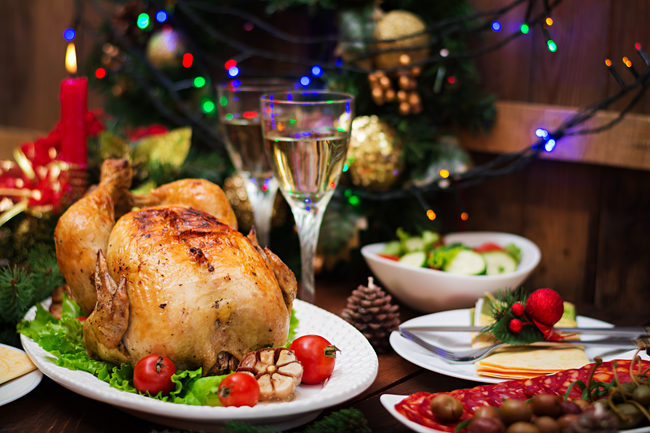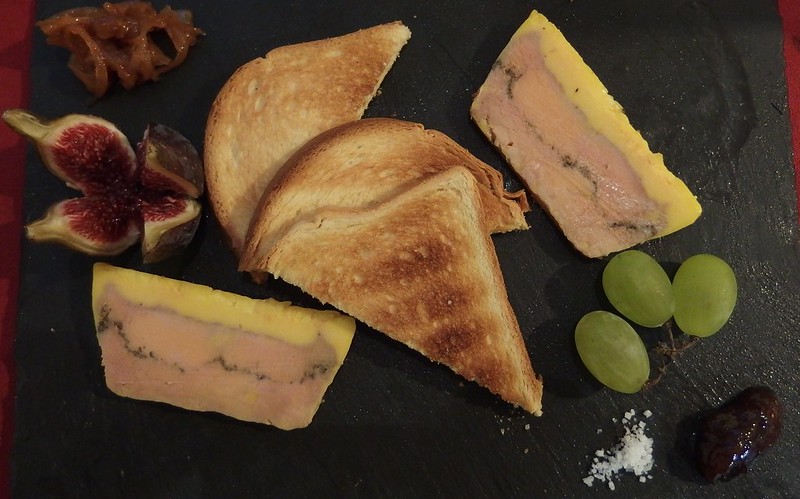Noël à la Française: Celebrating Christmas with my French Family
I moved from India to France three years ago. Not to sound dramatic, but trying to find a semblance of home in a new-to-you country can leave you with more than a few scrapes and bruises. Despite the cultural barriers (or maybe because of it), French food was my salve, as well as my entry point to connect to French culture and people, including my in-laws.
I now have a theory that I am almost certain is true: if you love food, and are curious about food, you’ll get along fine with French people! And what better way to get to know the French than by breaking bread with them during holiday festivities?
As elsewhere, each family probably has their own distinct traditions and quirks that makes the day meaningful for them. Here I’ll try to give you a peek into how we have celebrated Noël with my husband’s family over the past couple of years.

Strasbourg, capitale de Noël, le grand sapin in 2014. Photo credit: Claude Truong-Ngoc / Wikimedia Commons
Christmas with the In-Laws
As someone with no reference to Christmas before moving to France, but plenty of experience in joyous celebrations (I mean I come from the land of Holi and Diwali), I was prepared for my first Christmas dinner couple of years ago. My rusty French notwithstanding, I was well-rested, hydrated and more importantly, hungry. The last one is probably the most vital prerequisite for any family celebration.
“There’ll be a lot of food,” my husband warned me. “A lot,” he repeated, for added measure.
Like most celebrations in France, much of this day centers around meals. The prime locus for it all is the dinner table, and of course the Christmas tree. Though Christianity is still the dominant religion in France, many French people prefer to describe themselves as secular. Perhaps this is why Christmas itself is seen more as a joyous occasion to get together as a family, rather than a religious festival (at least that’s the case with my in-laws).

Chandua lanterns on display for Diwali. Photo credit: Vydurya Singh/ Wikimedia Commons
Over the years, I have also asked many of my French friends about what Christmas traditions they follow with their family, and invariably, the answer always involves food. So, if this article sounds more like “what I eat during Christmas in France,” you know why!
Also note that different regions in France have their own special dish associated with the holidays. As is well-known, the French are extremely proud of their terroir, hence many variations on different courses can be found in different regions of France.
Being from the Ariège region in the south of France, my husband’s family are hearty Ariégeois. While the region might be less sophisticated than nearby Bordeaux or not as cool as Marseille, it makes up for it with the beauty of the Pyrénées mountains, and the deliciousness of its produce.

Mont Valier (vu de la route du Port d’Aula), Couserans, Ariège, Pyrénées. Photo credit: Valier/ Wikimedia Commons
Le Réveillon de Noël: The Big Feast
In France, the majority of festivities takes place on Le Réveillon de Noël or Christmas Eve, rather than on Christmas Day. So, the main meal is the Christmas Eve dinner.
Here’s what’s on a standard Christmas Eve dinner menu in France:
Entrée en plusieurs étapes
The most traditional appetizers for a French Christmas meal are seafood, foie gras and charcuterie. Seafood usually consists of oysters and prawns.

French banquet style seafood dinner, Photo: llee_wu/Flickr
The first time I tasted foie gras, its cold, salty taste was simultaneously one of the most interesting and revolting things I had tried until that point in life. I guess it didn’t help to know that this buttery paste is made of fattened goose liver. I have since come around to acquiring a taste for it.
I can see why so many French still hold it dear to their heart. It is one of those foods the French eat to mark special occasions. As such the memory-associations with foie gras ever since childhood, means that it transcends to the realm of cherished delicacy. So much so that vegan French have created faux gras.
Personally, for me too, it’s not something I would crave, but something I enjoy sharing in family gatherings or while celebrating a special occasion with friends.
Foie gras can be served on regular bread, or more festive breads with raisins or currants: the sweetness of the vessel complementing the salty umami of the foie gras. A crack of fresh black pepper and/or fleur de sel up top, and the perfect bite of foie gras is ready! Mais attention: foie gras is never to be spread like butter. That’s apparently the quickest way to offend a table full of French. Don’t ask me why. I don’t make the rules.
To finish off, there’s the charcuterie, made up of a wide assortment of cold cuts, served with cornichons, tiny pickled cucumbers. With my family, we usually get whatever cold cuts looks good to eat at the farmer’s market that week.
The first course is to be served with Champagne or white wine.
Among non-traditional appetizers, my family incorporates Indian dishes in the mix. It’s my in-laws’ way of celebrating my heritage. So, much to the surprise of many, dishes such as masala chicken or Indian-style vegetable fritters will be served for the dîner de Noël or any other celebratory dinner.
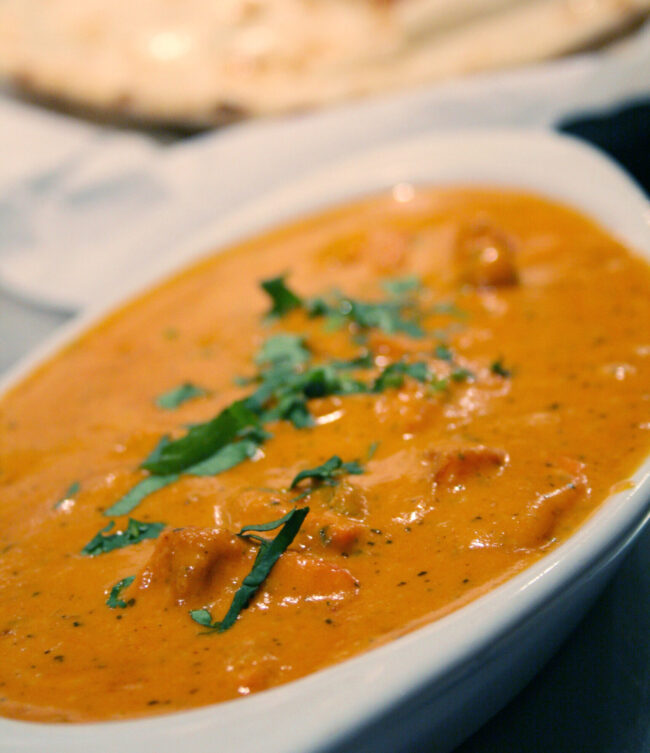
Chicken Tikka Masala and Naan. Photo credit: Michael Hays / Wikimedia commons
Plat
The most traditional food to eat for the main course on Christmas, is le chapon farçi or stuffed capon, a poultry bird that’s way bigger than a chicken.
The stuffing for the chapon would differ according to taste and region, but could include everything from basic onion and herbs, to the decadent foie gras! Yes, things can escalate very fast.
The bird is slathered with a blend of butter, minced garlic and herbs like thyme, rosemary, and sage, along with salt and pepper. My mother-in-law usually prepares capon stuffed with the classic French trinity of onion, shallots and celery, plus garlic, chestnuts and bread to soak in all delicious juices. Roasted on a bed of more chestnuts and winter vegetables like carrots, potatoes and butternut, it’s the perfect plate of winter comforts. Of course, le jus de viande or meat sauce is whisked up, using the juices and sticky bits from the roast meat, which is then deglazed with wine and whipped up into a thick sauce, to be poured all over, well, everything on my plate.
Coupled with a well-bodied red wine, this is the highlight of the whole meal. And, needless to say, it’s delicious!
For some members of our family, eating a leafy salad before or after the main course is almost a given. It’s usually lettuce or rocket or some other greens, topped with a splash of olive oil and balsamic vinegar. Since I am yet to become a salad person, I have to confess, this is not the most exciting part of the meal for me.
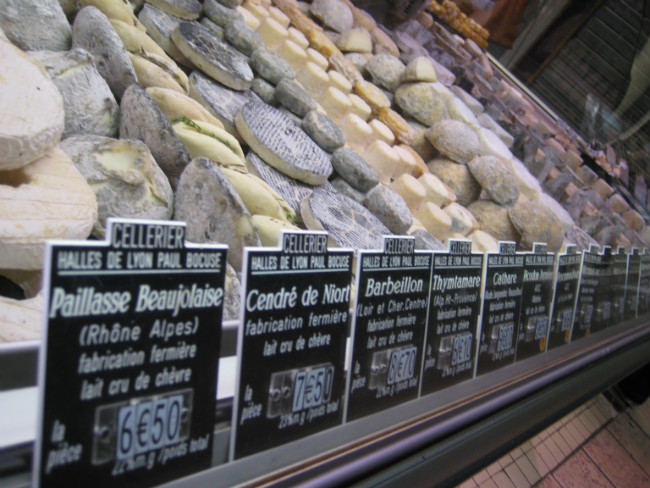
“Fromage”. Photo credit: karaian/Flickr
Fromage et Dessert
Since we are in France, cheese towards the end of the meal is obvious. This too would change according to region and taste.
In our family, it is typical to take a break between the cheese course and the dessert to open presents. Stuffed and happy, we all set off finding out what Père Noël (Santa Claus) brought us. Once everything has been opened, and some more space created in our bellies, we sit down to continue the dinner, and enjoy the quintessential Christmas dessert, la bûche de Noël, accompanied by Champagne.
Bûche de Noël literally translates to “log of Christmas” or the Yule log. It is a cylindrical dessert, made by folding sponge cake into the shape of a log, in different flavors such as chocolate, crème aux marrons (chestnut paste) or what have you. You can also find bûche de Noël made of ice-cream.
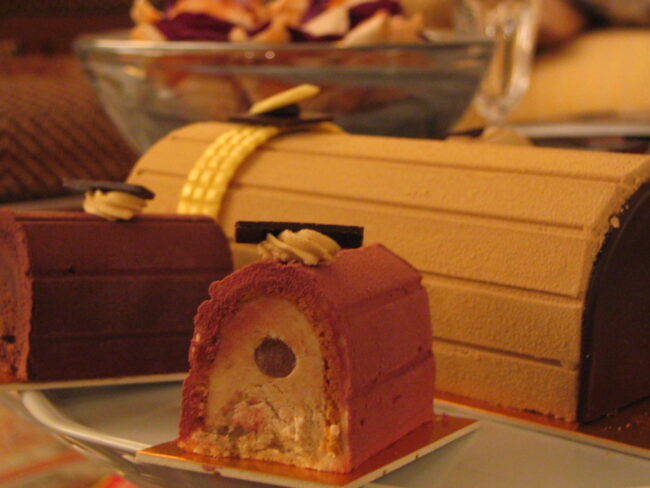
Contemporary ice cream versions of the Bûches de Noël. Photo credit: Ziel / Wikipedia commons
After the meal, some families go for the Midnight Mass. I haven’t been to one yet, so that’s definitely something I would like to experience.
This year, my husband and I are looking forward to hosting Christmas Eve dinner at our home. While we will honor French culinary traditions for the Christmas feast, we’re also planning to add Indian dishes, such as grilled paneer, an Indian cheese, served with fresh mint chutney as an appetizer, and kheer, an Indian rice pudding made with milk, nuts and raisins. After all, what is a festive family meal, if not an occasion to share our stories? And for many of us, there is no better way to express it but through the foods we cook for the people we love.
I wish you a joyous Christmas with lots of good foods, and more importantly, the company of people you love.

Advent wreath. Photo credit: Bubamara / Wikimedia commons
Lead photo credit : Christmas table served with turkey. Photo: Timolina/Freepik
More in Christmas, Paris Christmas
